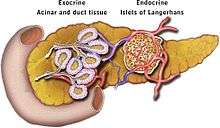Type 3c (Pancreatogenic) Diabetes

Type 3c diabetes (also known as Pancreatogenic diabetes) is a form of diabetes that is being researched. It involves the exocrine and digestive functions of the pancreas. Out of all the diabetics, 5–10% are actually type 3c diabetics. In 80% of people who suffer from this condition, chronic pancreatitis seems to be the cause.[1]
Cause
There are multiple causes. Some of which identified are:
- Pancreatic disease
- Pancreatic resection
- Chronic pancreatitis (caused by exocrine insufficiency, maldigestion, and malnutrition).[2]
- Lacking genes in the E2F group.[3]
More possible causes are being researched.
Diagnosis
| Diagnostic Criteria for T3cDM |
|---|
| Major criteria (all must be fullfilled): |
|
| Minor Criteria: |
|
Management
The condition can be managed by many factors.
Lifestyle Modifications
Avoiding toxins to the body such as alcohol and smoking reduce pancreatic inflammation. Also, eating a diet rich in fiber and consuming normal amounts of fat may help. Oral pancreatic enzymes may be given. Maintaining sufficient levels of vitamin D can also reduce symptoms and help manage the disease better.
Treatments
Multiple treatments are available.
Anti-Hyperglycemic Agents
Medications such as insulin may be given in order to lower blood sugars. For not so high blood sugars, oral treatments in the form of a pill or capsule may be given.
Total Pancreatectomy with Islet Autotransplantation
A total pancreatectomy may be performed and Islet cells may be transplanted.
Complications
The same complications that occur for other types of diabetics (type 1 and type 2) may occur for type 3c diabetics. These include retinopathy, nephropathy, neuropathy, and cardiovascular disease. Patients with this condition are advised to follow the same risk-reduction guidelines as the other diabetics do and keep blood sugars as normal as possible to minimize any complications.
See also
References
- ↑ Ewald, Nils; Hardt, Philip D (2013-11-14). "Diagnosis and treatment of diabetes mellitus in chronic pancreatitis". World Journal of Gastroenterology : WJG. 19 (42): 7276–7281. doi:10.3748/wjg.v19.i42.7276. ISSN 1007-9327. PMC 3831209
 . PMID 24259958.
. PMID 24259958. - ↑ "Diabetes in Chronic Pancreatitis". Medscape. Anand R. Gupte and Chris E. Forsmark. Retrieved 2016-07-09.
- ↑ "Study shows molecular mechanism behind type 3c pancreatic diabetes". News Medical. August 29, 2012. Retrieved July 9, 2016.